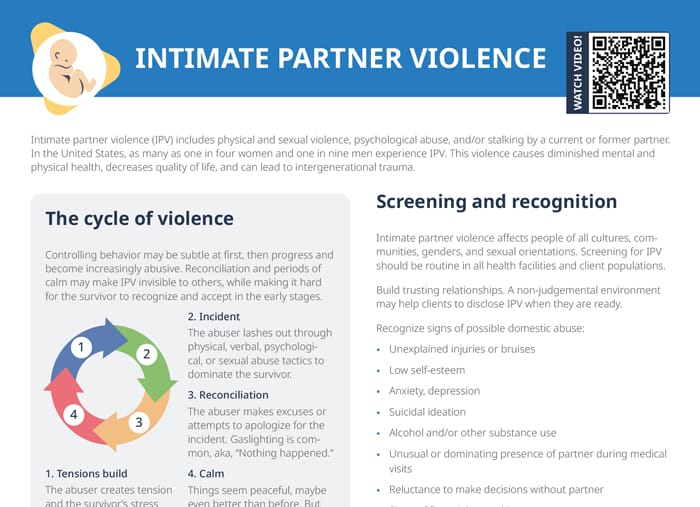What is intimate partner violence?
Intimate partner violence (IPV) includes physical and sexual violence, psychological abuse, and/or stalking by a current or former partner.
In the United States, as many as one in four women and one in nine men experience IPV. This violence causes diminished mental and physical health, decreases quality of life, and can lead to intergenerational trauma.
Signs of abuse in relationships
Intimate partner violence affects people of all cultures, communities, genders, and sexual orientations. Signs of domestic abuse should be looked for in all health facilities and client populations:
- Unexplained injuries or bruises
- Low self-esteem
- Anxiety, depression
- Suicidal ideation
- Alcohol and/or other substance use
- Unusual or dominating presence of partner during medical visits
- Reluctance to make decisions without partner
- Signs of financial control by partner
- Pregnancy complications such as preterm birth or placental abruption
Signs of emotional abuse
Emotional abuse comes in many forms including belittling, constant criticism, insults, threats, control and isolation, gaslighting, or destruction of possessions. Signs in clients are mainly low self-esteem, anxiety, depression, a withdrawal from usual activities, or reluctance to discuss home life.
Signs of narcissistic abuse
Narcissistic abuse specifically is characterized by a lack of empathy and disregard for the survivor’s feelings and well-being. It comes with manipulation and a sense of entitlement for special treatment at the expense of the survivor. In the survivor, this can present as them feeling worthless, confused due to gaslighting, symptoms of trauma, or difficulty making independent decisions.
Signs of sexual abuse in adults
Sexual abuse in intimate partner relationships can include coercion/pressuring or sexual insults or criticism in the form of degrading comments. Physical signs can, for example, include bruises or injuries around the breasts, genitals, or anus, or STIs. Avoidance of gynecological exams, anxiety/depression, changes in sexual behavior and reluctance to discuss the intimate relationship can be further signs to look out for.
The cycle of domestic violence
Controlling behavior may be subtle at first, then progress and become increasingly abusive.
Reconciliation and periods of calm may make IPV invisible to others, while making it hard for the survivor to recognize and accept in the early stages.
- Tensions build: abuser creates tension, survivor’s stress builds
- Incident happens: abuser lashes out
- Reconciliation: abuser makes excuses, gaslighting
- Calm phase: seems peaceful, cycle starts over soon
What is the relationship between intimate partner violence (IPV) and marriage?
IPV can occur in all types of intimate relationships, including marriage. However, in some cultures or communities, there might be expectations or norms that inadvertently condone or overlook abusive behaviors within a marriage, making it harder for survivors to seek help or even recognize abuse. Married victims of IPV might face social stigma or lack of support when seeking help. Further barriers to leaving an abusive marriage can be posed by concerns about divorce, custody of children, financial security, and legal status.
Nursing tips
Build a trusting relationship with clients. A non-judgmental environment may help clients to disclose IPV.
Be prepared
- Know local resources.
- Have protocols for referral in place.
- Learn about IPV.
Follow the client’s lead
- Listen without judgment!
- Ask what the client needs.
- Understand that ending the relationship may not be a safe option for the client.
Leaving the relationship is often the most dangerous time for those experiencing IPV.
Know the reporting requirements in your state
- Most states do not mandate reporting of domestic violence against adults.
- Nonconsensual reporting can increase the risk for clients experiencing IPV.
- Always put client safety first.
Help create a safety plan
Safety planning may include:
- Preparing a “go bag” with personal documents and money in case of need to leave quickly
- Identifying who they will contact
- Identifying where they will go
- Planning how they will signal for help if partner is present or preventing them from leaving

